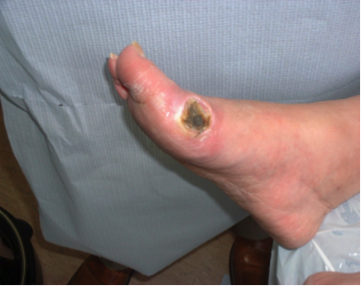
Debridement
Ulcer debridement, where necessary, facilitates accurate examination of the wound bed and can contribute to ulcer healing. However, debridement should only be carried out by trained competent professionals. Debridement of slough and necrotic tissue allows the clinician to assess the true size and depth of an ulcer as well as reducing the surface bacterial burden.
Debridement also contributes to accurate identification of ulcer infections, by improving direct visualisation of the ulcer bed and permitting deeper microbiological swabs. In the case below, image 1 shows the ulcer before debridement and the subsequent image 2 after debridement demonstrates fragmented bone removal, indicating a more serious infection and allowing bone fragments to be sent for bacterial culture.
It is also well documented that ulcer debridement may be helpful for the healing of foot ulcers. Increased pressure due to callous formation can delay the healing process and debridement can remove this inhibition of ulcer healing.
Caution with debridement should be exercised however in patients with peripheral arterial disease, in whom further damage to surrounding tissue could delay healing. Before any debridement is considered, the patient should provide informed consent and understand that during the procedure the ulcer may bleed and debridement may result in the apparent ulcer size increasing.

Image 1: pre debridement

Image 2: with Fragmented bone
